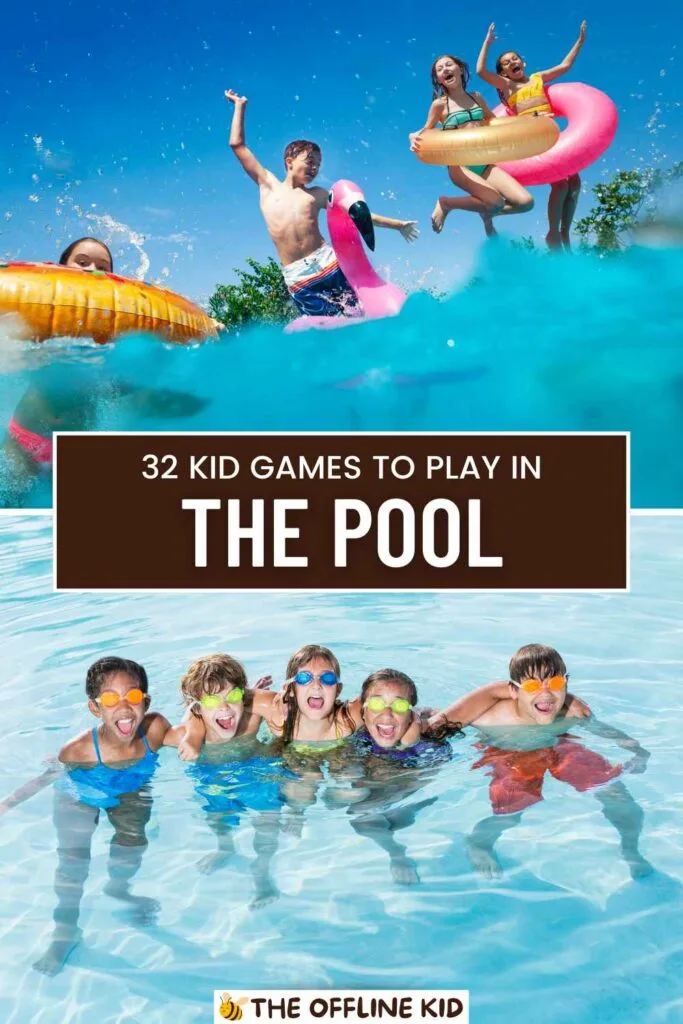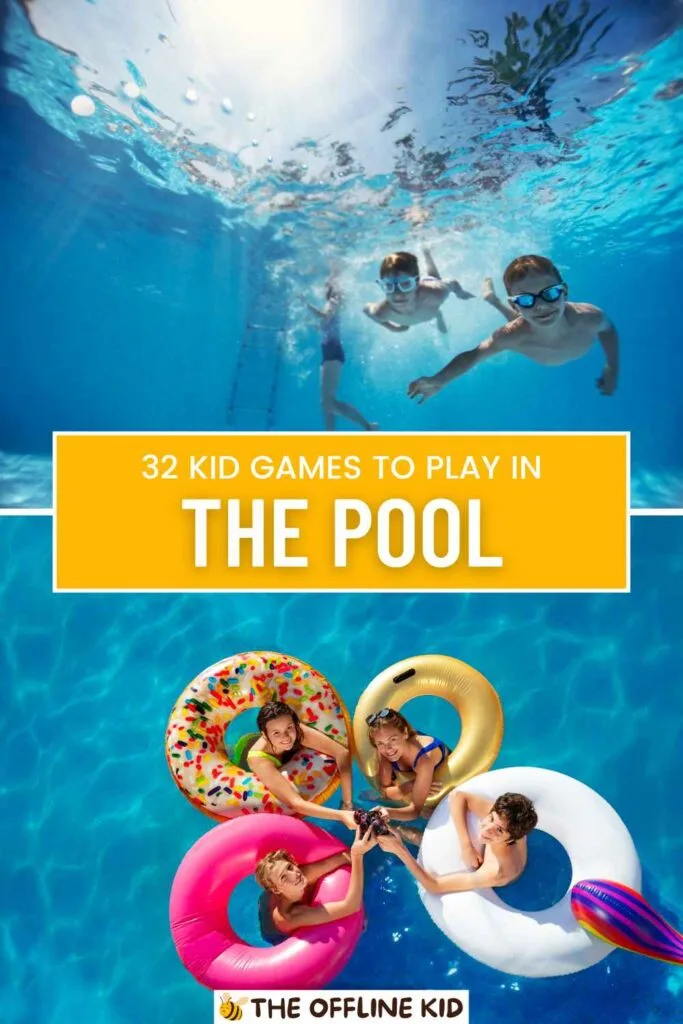Classic pool games bring timeless fun and excitement to any swimming session. These games are beloved by kids and offer endless opportunities for laughter, exercise, and creative play.
Dive into these classic pool games that have stood the test of time and continue to be favorites among children.
Classic Pool Games
How to Play:
- One player is chosen to be “Marco” and closes their eyes.
- The other players spread out around the pool.
- “Marco” calls out “Marco!” and the other players must respond with “Polo!”
- Using the sound of their voices, “Marco” tries to tag one of the other players.
- The player who is tagged becomes the new “Marco.”
Variations:
- Blindfold Marco: Use a blindfold to ensure “Marco” keeps their eyes closed.
- Silent Polo: Players can choose to remain silent, only responding occasionally.
- Shallow End Only: Limit the game to the shallow end for younger children.
Tips:
- Emphasize the importance of keeping eyes closed to make the game fair.
- Encourage players to change their location often to make it more challenging for “Marco.”
Sharks and Minnows
How to Play:
- Choose one player to be the “shark” and the rest are “minnows.”
- “Minnows” line up at one end of the pool, while the “shark” stays in the middle.
- When the “shark” yells “Go,” the “minnows” must swim to the other side without getting tagged.
- Any “minnow” tagged becomes a “shark” for the next round.
Tips for Making It More Fun:
- Add a rule where tagged “minnows” must freeze until another “minnow” frees them by tagging.
- Use pool noodles as “shark” fins to add a fun visual element.
- Encourage players to come up with strategies to avoid getting tagged, such as swimming underwater.
Diving for Treasures
Equipment Needed:
- Dive rings or sticks
- Small pool toys or coins
How to Play:
- Scatter the dive rings or toys across the pool floor.
- Players take turns diving to collect as many items as they can in a set time.
- The player with the most collected items wins.
Different Ways to Play:
- Timed Challenge: See who can collect the most items in a minute.
- Team Dive: Split into teams and compete to gather the most treasures.
- Underwater Relay: Players take turns diving and handing off items to their teammates.
Safety Tips:
- Ensure all players are comfortable with diving and swimming underwater.
- Use brightly colored items that are easy to spot.
These classic pool games are sure to bring joy and excitement to any pool day, providing endless entertainment and active fun for kids of all ages.
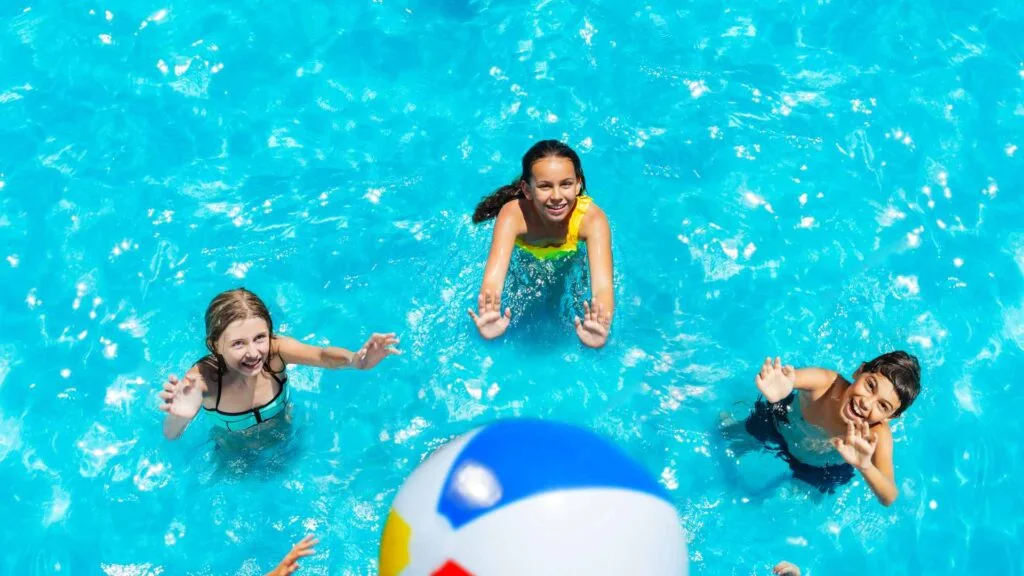
Tag-Based Pool Games
Octopus Tag
How to Play:
- Choose one player to be the “octopus” who starts in the middle of the pool.
- The other players, known as “fish,” line up at one end of the pool.
- The “octopus” calls out “Octopus!” and the “fish” try to swim to the opposite end without getting tagged.
- Any “fish” tagged becomes part of the octopus and must hold hands with the original “octopus.”
- The game continues until all players are part of the octopus.
Strategies for Staying Untagged:
- Swim underwater to avoid detection.
- Change directions quickly to outmaneuver the “octopus.”
- Use the pool edges to your advantage.
Fish Out of Water
Rules and Gameplay:
- One player is designated as “It” and stays on the pool deck or side.
- The other players swim and try to avoid being tagged by “It.”
- “It” can call out “Fish out of water!” at any time, and if any players are out of the water, they are tagged and become “It.”
- Players can swim underwater to avoid detection but must come up for air occasionally.
Common Strategies:
- Stay underwater as long as possible to avoid being called out.
- Use quick dives and resurfaces to confuse “It.”
- Keep moving and change positions frequently.
These tag-based pool games add an extra layer of excitement and challenge to pool time, encouraging kids to be strategic and active while having fun with their friends.
Racing Pool Games
Relay Races
Types of Relay Races:
- Standard Relay: Teams of players swim one at a time to a designated point and back, tagging the next teammate to go.
- Medley Relay: Each team member swims a different stroke (freestyle, backstroke, breaststroke, butterfly).
- Floatie Relay: Players use pool floaties to swim their leg of the race.
How to Organize Teams:
- Divide players into equal teams.
- Ensure each team has a mix of strong and weaker swimmers to balance the competition.
- Set clear start and finish points for the race.
Tips:
- Use a whistle or another signal to start each race.
- Encourage teamwork and cheering for teammates.
- Mix up the types of relays to keep the games exciting.
Swimming Races
Different Styles of Races:
- Freestyle Race: Players swim using any stroke they prefer.
- Backstroke Race: Players swim on their backs.
- Butterfly Race: Players swim using the butterfly stroke.
- Underwater Race: Players swim underwater for as long as they can before surfacing.
Tips for Different Age Groups:
- For younger kids, keep the race distance shorter and focus on fun rather than competition.
- For older kids, increase the distance and introduce more challenging strokes.
Safety Considerations:
- Ensure the race distance is appropriate for all swimmers’ skill levels.
- Have a lifeguard or adult present to monitor the races.
Underwater Swimming Challenge
How to Set Up:
- Mark a start and end point in the pool.
- Players take turns swimming underwater from the start to the end point.
Safety Considerations:
- Ensure players are comfortable swimming underwater.
- Monitor for signs of distress and have adults present to supervise.
Variations:
- Longest Breath: See who can stay underwater the longest while swimming.
- Underwater Relay: Teams compete by passing a baton or small object underwater.
These racing pool games not only provide a great way to expend energy but also help improve swimming skills, encouraging a healthy sense of competition and teamwork among kids.
Ball Games
Pool Volleyball
Equipment and Setup:
- A net that can span the width of the pool
- A beach ball or lightweight volleyball
How to Play:
- Divide players into two teams.
- Set up the net across the middle of the pool.
- Teams take turns serving the ball over the net, trying to score points by making the ball land in the opposing team’s side of the pool.
- The first team to reach a set number of points wins.
Rules and Variations:
- Standard volleyball rules apply (three hits per side, no carrying the ball, etc.).
- No Hands: Players can only use their heads and feet to hit the ball.
- Water Polo Volleyball: Combine elements of water polo and volleyball for a unique twist.
Tips:
- Use a larger beach ball for younger children to make it easier to hit.
- Emphasize the importance of teamwork and communication.
Pool Basketball
Equipment and Setup:
- A floating or poolside basketball hoop
- A waterproof basketball
How to Play:
- Players take turns shooting the ball into the hoop.
- Assign point values to different shot distances.
- Play one-on-one, or divide into teams for a full game.
Rules and Tips:
- Free Throws: Players must shoot from a designated spot.
- Horse: Similar to the basketball game HORSE, players try to replicate each other’s shots.
- Ensure the hoop is securely anchored to avoid tipping.
Water Polo
How to Play:
- Divide players into two teams.
- Set up goals at each end of the pool.
- Players pass the ball to teammates, aiming to score in the opposing team’s goal.
- The team with the most goals at the end of the game wins.
Simplified Rules for Kids:
- Allow players to hold the ball with both hands.
- Reduce the size of the playing area to keep the game manageable.
- Emphasize passing and teamwork over physical contact.
Tips:
- Use a soft, waterproof ball to prevent injuries.
- Encourage fair play and good sportsmanship.
These ball games bring a dynamic and engaging element to pool time, offering kids a chance to improve their coordination and teamwork while having a blast.
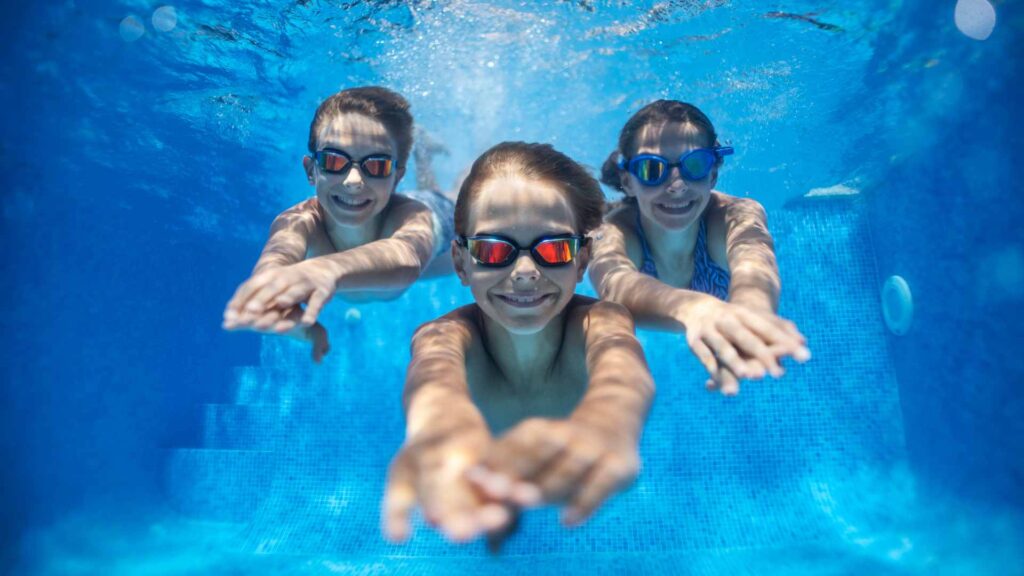
Floating and Sinking Games
Floatie Race
Types of Floaties to Use:
- Pool noodles
- Inflatable rafts
- Inner tubes
How to Set Up a Race:
- Mark a start and finish line in the pool.
- Each player or team gets a floatie.
- On “Go,” players race to the finish line using their floaties.
Variations:
- Backward Floatie Race: Players must navigate the course while sitting backward on their floaties.
- Relay Floatie Race: Teams of players take turns racing with the floatie, passing it off to the next teammate.
Tips:
- Ensure floaties are appropriate for the players’ sizes.
- Use a whistle to start the race and signal the end.
Sink or Float
How to Play:
- Gather various pool-safe objects (e.g., plastic toys, coins, rubber ducks).
- Players take turns guessing if each item will sink or float.
- Drop the item into the pool to see who guessed correctly.
Educational Aspects:
- Discuss why some objects sink while others float (density, material, etc.).
- Encourage kids to make predictions and test their hypotheses.
Variations:
- Timed Sink or Float: Set a timer for how long each object takes to sink or float.
- Sink or Float Relay: Players race to collect floating or sinking objects and bring them back to the starting point.
Safety Tips:
- Ensure objects used are safe and won’t cause harm if stepped on.
- Monitor younger children closely to prevent swallowing small items.
These floating and sinking games provide a mix of active fun and educational opportunities, helping kids learn about buoyancy and teamwork while enjoying their time in the pool.
Treasure Hunt Games
Pirate Treasure Hunt
How to Organize:
- Treasure Items: Use pool-safe items like coins, plastic gems, or small toys as treasures.
- Clues and Maps: Create a simple treasure map or write clues leading to different parts of the pool.
- Treasure Chest: Use a waterproof container as the treasure chest.
How to Play:
- Hide the treasures around the pool before the game starts.
- Give players the map or first clue to start the hunt.
- Players follow the clues to find the hidden treasures.
- The player or team that finds the most treasures wins.
Tips:
- Make sure all treasures are brightly colored and easy to spot.
- Adjust the difficulty of the clues based on the age of the players.
- Consider using themed costumes or props for added fun.
Scavenger Hunt
Creating a List of Items:
- Make a list of items for players to find around the pool, such as a blue pool noodle, a red ball, a diving ring, etc.
- Include both easy and challenging items to keep it interesting.
How to Play:
- Divide players into teams or let them play individually.
- Give each player or team a list of items to find.
- Players search the pool area to collect the items on their list.
- The first player or team to find all the items wins.
Tips for Organizing the Game:
- Set a time limit to add excitement and urgency.
- Use a mix of floating and sinking items to make the search more challenging.
- Offer small prizes for the winners, such as pool toys or treats.
These treasure hunt games are perfect for encouraging exploration and adventure in the pool, keeping kids engaged and active while sparking their imaginations.
Creative Pool Games
Mermaid Races
How to Play:
- Players wear mermaid tails or hold their legs together while swimming.
- Set a start and finish line in the pool.
- On “Go,” players race to the finish line using only their legs to swim, mimicking mermaid movements.
Ideas for Making It Fun:
- Costumes: Encourage players to wear mermaid-themed costumes or accessories.
- Relay Races: Divide players into teams for relay races, passing a baton or small toy to the next swimmer.
- Obstacle Course: Add pool noodles or floating hoops to create an obstacle course.
Underwater Tea Party
How to Set Up:
- Use a shallow area of the pool where kids can sit on the pool floor.
- Provide waterproof tea sets or plastic cups and plates.
- Arrange the items on the pool floor as if setting up a tea party.
Encouraging Imaginative Play:
- Kids can pretend to be sea creatures or underwater royalty.
- Encourage them to create stories and roles for each participant.
- Take turns “pouring” tea and serving “food” to each other.
Pool Noodle Jousting
Equipment Needed:
- Pool noodles
- Floating rafts or inner tubes
How to Play:
- Players sit on rafts or inner tubes in the pool, holding a pool noodle as their “jousting lance.”
- On “Go,” players paddle towards each other and try to knock their opponent off their raft using the pool noodle.
- The last player remaining on their raft wins.
Rules and Safety Tips:
- Only use pool noodles to avoid injuries.
- Players must stay seated on their rafts during the game.
- Ensure there are no sharp edges or obstacles in the pool area.
Variations:
- Team Jousting: Pair players up and have them compete in teams.
- Timed Jousting: See who can stay on their raft the longest within a set time limit.
These creative pool games inspire imagination and add a unique twist to pool time, providing endless opportunities for fun and playful interaction among kids.
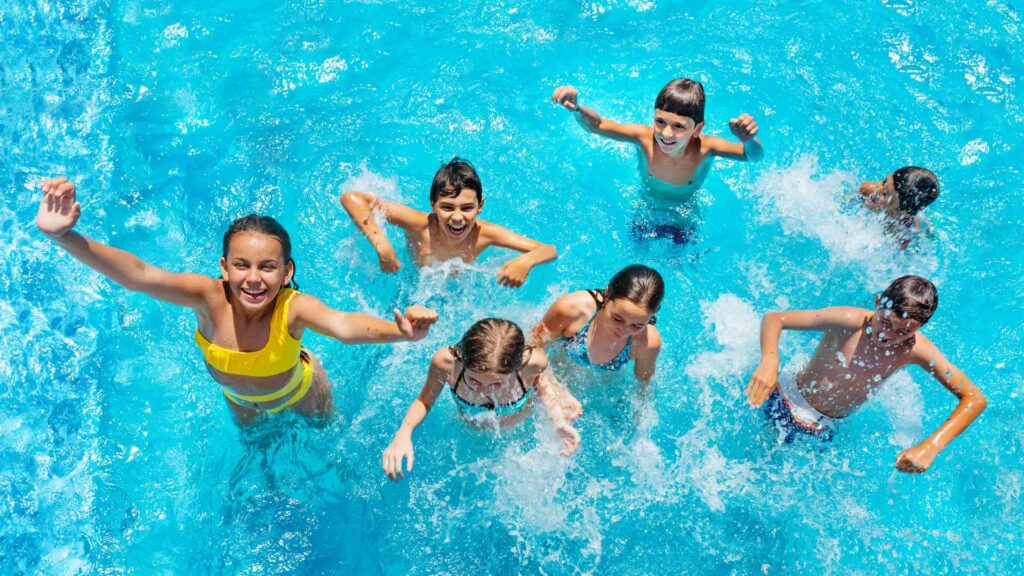
Relay and Team Games
Ball Relay
How to Set Up:
- Divide players into two or more teams.
- Each team lines up at one end of the pool.
- Provide a ball for each team (beach ball, foam ball, etc.).
How to Play:
- The first player in each team swims to the other end of the pool and back while holding the ball.
- They pass the ball to the next teammate, who repeats the process.
- The first team to have all its members complete the relay wins.
Variations:
- Underwater Ball Relay: Players must swim underwater while holding the ball.
- Obstacle Relay: Set up obstacles in the pool that players must navigate around while carrying the ball.
Tips:
- Ensure balls are lightweight and easy to hold.
- Emphasize the importance of passing the ball securely to avoid dropping it.
Synchronized Swimming
How to Create Routines:
- Divide players into small groups.
- Groups create a synchronized swimming routine to perform in the pool.
- Routines can include coordinated movements, underwater spins, and simple formations.
Fun Ideas for Kids:
- Themed Routines: Assign themes like “Under the Sea” or “Space Adventure” for added creativity.
- Music: Play fun, upbeat music to accompany the routines.
- Props: Use pool noodles, floaties, or water toys as part of the routine.
Tips:
- Encourage teamwork and practice to perfect the routine.
- Allow each group to perform their routine for the other players.
Capture the Flag
How to Adapt for the Pool:
- Divide players into two teams.
- Place a “flag” (a brightly colored object) at each team’s base on opposite sides of the pool.
- Teams try to capture the other team’s flag and bring it back to their own base without being tagged.
Strategies for Playing:
- Defense: Assign players to guard their flag and tag opponents trying to capture it.
- Offense: Plan coordinated attacks to distract the opposing team and capture the flag.
- Safe Zones: Designate areas where players cannot be tagged to catch their breath and plan their next move.
Tips:
- Use brightly colored flags or objects that are easy to spot.
- Emphasize the importance of fair play and good sportsmanship.
These relay and team games promote cooperation, strategy, and active play, making them perfect for group activities in the pool. They offer a mix of competition and fun, ensuring all kids stay engaged and entertained.
Splash and Spray Games
Cannonball Contest
How to Judge:
- Gather all players at the edge of the pool.
- One by one, players take turns jumping into the pool and attempting to make the biggest splash.
- Designate judges (adults or other kids) to rate the splashes on size, height, and creativity.
Tips for Safe Jumps:
- Ensure the jumping area is deep enough for safe cannonballs.
- Have a designated area for jumping to avoid collisions.
- Remind players to jump straight into the pool and not towards the sides.
Variations:
- Creative Cannonballs: Players are encouraged to add unique twists to their jumps, like spinning or shouting funny phrases mid-air.
- Team Cannonballs: Pair up players and have them jump simultaneously to create combined splashes.
Splash Contest
How to Play:
- Players line up at the pool’s edge.
- On “Go,” all players jump or dive into the pool, trying to create the biggest splash.
- Judges rate each splash on height, width, and overall impact.
Tips for Making Big Splashes:
- Jump with knees pulled to the chest for a classic cannonball.
- Use diving boards if available to gain more height for the splash.
- Encourage different jumping techniques, like star jumps or belly flops, for variety.
Safety Tips:
- Ensure the jumping area is clear of other swimmers.
- Only allow one jumper at a time for individual splash contests.
- Have adults or lifeguards supervise to ensure safe jumping practices.
Water Limbo
Equipment Needed:
- A long, flexible pole or pool noodle
How to Play:
- Two players hold the pole or noodle horizontally above the water.
- Players take turns swimming under the pole without touching it.
- After each round, lower the pole slightly to increase the difficulty.
Rules and Tips:
- Players must keep their faces above water while going under the pole.
- If a player touches the pole or falls, they are out of the game.
- Encourage players to try different swimming techniques, such as the backstroke or side swim, to clear the pole.
Variations:
- Underwater Limbo: Players must swim entirely underwater to pass under the pole.
- Timed Limbo: Add a timer to see who can complete the limbo course the fastest.
These splash and spray games add a refreshing and exhilarating element to pool time, ensuring kids stay active and entertained with plenty of laughter and excitement.
Balance and Skill Games
Floatie Balance
How to Set Up:
- Provide each player with a floatie (pool noodle, inflatable raft, or inner tube).
- Designate a starting and finishing point in the pool.
How to Play:
- Players must sit or stand on their floatie and balance without falling off.
- The goal is to reach the finish line while maintaining balance.
Variations:
- Timed Balance: See who can stay balanced the longest without falling off.
- Obstacle Course: Set up obstacles that players must navigate around while balancing on their floaties.
Tips:
- Encourage players to use their arms for balance.
- Use different types of floaties to vary the difficulty level.
Water Limbo
Equipment Needed:
- A long, flexible pole or pool noodle
How to Play:
- Two players hold the pole or noodle horizontally above the water.
- Players take turns swimming under the pole without touching it.
- After each round, lower the pole slightly to increase the difficulty.
Rules and Tips:
- Players must keep their faces above water while going under the pole.
- If a player touches the pole or falls, they are out of the game.
- Encourage players to try different swimming techniques, such as the backstroke or side swim, to clear the pole.
Variations:
- Underwater Limbo: Players must swim entirely underwater to pass under the pole.
- Timed Limbo: Add a timer to see who can complete the limbo course the fastest.
Underwater Handstand Contest
How to Play:
- Players take turns performing handstands underwater.
- Judges rate each handstand on duration, stability, and creativity.
- The player with the highest score wins.
Tips for Longer Handstands:
- Encourage players to practice holding their breath.
- Use the pool floor for balance by planting hands firmly.
- Suggest practicing different leg positions, such as straight legs or splits, for added creativity.
Safety Tips:
- Ensure players are comfortable holding their breath and being upside down in the water.
- Have adults or lifeguards supervise the contest to ensure safety.
These balance and skill games help improve coordination, focus, and confidence in the water, providing a fun challenge for kids to test and enhance their aquatic abilities.
Educational Pool Games
Water Alphabet
How to Play:
- Players take turns creating letter shapes with their bodies in the water.
- Other players guess the letter being formed.
- For younger kids, use floating alphabet toys that they can arrange in the water.
Educational Benefits:
- Enhances letter recognition and spelling skills.
- Encourages creativity and body awareness.
Variations:
- Word Formation: Have players form entire words instead of single letters.
- Alphabet Relay: Teams race to form the entire alphabet, one letter at a time.
Tips:
- Use large, exaggerated movements to make the letters more recognizable.
- Encourage teamwork by having players work together to form complex letters.
Number Hunt
How to Set Up:
- Place numbered objects or waterproof number cards around the pool.
- Ensure the numbers are brightly colored and easy to spot.
How to Play:
- Players dive and swim to find the numbers in sequential order.
- The player who finds all the numbers first wins.
Learning Opportunities:
- Improves number recognition and counting skills.
- Teaches sequential thinking and memory.
Variations:
- Math Challenges: After finding a number, players must solve a simple math problem before continuing.
- Team Number Hunt: Players work in teams to find and arrange the numbers.
Safety Tips:
- Ensure all objects are safe for pool use and won’t cause harm if stepped on.
- Supervise younger children closely to prevent swallowing small items.
Water Science Experiments
Types of Experiments:
- Buoyancy Tests: Test different objects to see if they float or sink.
- Water Displacement: Use a container to measure how much water is displaced by different objects.
- Temperature Changes: Explore how the temperature of water changes with ice or warm water.
How to Set Up:
- Gather safe, waterproof items for experiments.
- Use clear plastic containers for better visibility.
- Provide instructions and explanations for each experiment.
Educational Benefits:
- Introduces basic science concepts in a fun and interactive way.
- Encourages curiosity and experimentation.
Tips:
- Explain the science behind each experiment to enhance learning.
- Encourage kids to make predictions and observe the outcomes.
These educational pool games combine fun with learning, making pool time an opportunity for kids to explore, discover, and develop new skills while enjoying the water.
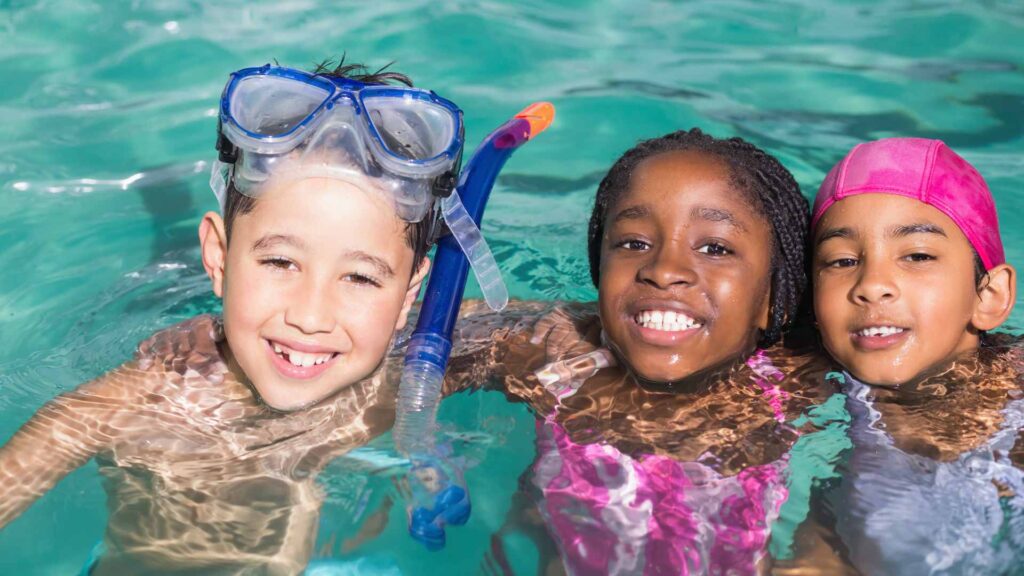
Fun with Pool Toys
Water Gun Fight
Types of Water Guns to Use:
- Small, easy-to-handle water pistols for younger kids.
- Larger, pump-action water guns for older kids.
How to Play:
- Divide players into teams or have a free-for-all battle.
- Players use water guns to spray each other, aiming to avoid getting wet themselves.
- Set boundaries for the play area to keep the action contained.
Safety Tips:
- Ensure water guns are appropriate for the age and strength of the players.
- Remind players not to aim at faces, especially eyes.
- Have a lifeguard or adult supervise the game.
Variations:
- Capture the Flag: Combine water gun fights with a capture the flag game.
- Target Practice: Set up floating targets for players to aim at instead of each other.
Beach Ball Bonanza
Different Games with Beach Balls:
- Beach Ball Volleyball: Set up a net and use a beach ball for a fun, easy-to-hit game of volleyball.
- Beach Ball Tag: One player is “It” and must tag others by hitting them with a beach ball.
- Keep It Up: Players work together to keep the beach ball from touching the water.
Tips for Keeping It Safe:
- Use lightweight, inflatable beach balls to avoid injuries.
- Ensure players understand the rules and boundaries of each game.
- Encourage gentle play to prevent roughhousing.
Water Balloon Toss
How to Play:
- Fill several water balloons and have players pair up.
- Players stand a short distance apart and toss a water balloon back and forth.
- After each successful toss, players take a step back.
- The pair that manages the longest toss without breaking their balloon wins.
Safety Tips:
- Use small, easy-to-handle water balloons.
- Remind players to toss gently to avoid injuries.
- Clean up any balloon remnants to keep the pool area safe and tidy.
Tips:
- Fill balloons with different amounts of water for added challenge.
- Use different colored balloons to designate teams or rounds.
Floating Ring Toss
How to Set Up:
- Place floating rings or hoops in the pool at varying distances.
- Provide players with small balls or bean bags to toss into the rings.
How to Play:
- Players take turns tossing balls or bean bags into the floating rings.
- Assign points based on the distance of the rings, with farther rings earning more points.
- The player with the most points at the end wins.
Variations:
- Timed Ring Toss: Players have a set amount of time to score as many points as possible.
- Team Ring Toss: Players compete in teams, combining their scores for a team total.
Tips:
- Use brightly colored rings and balls to make them easy to see.
- Adjust the distance of the rings based on the age and skill level of the players.
These pool toy games add an extra layer of excitement and variety to pool activities, ensuring kids stay entertained and engaged with fun, interactive play.
Night-Time Pool Games
Glow Stick Pool Tag
How to Set Up:
- Equip each player with glow sticks (bracelets, necklaces, etc.).
- Ensure the pool area is safely lit, but keep the water area dim to enhance the glow effect.
How to Play:
- Choose one player to be “It.”
- Players swim and move around the pool, trying to avoid being tagged by “It.”
- The glow sticks make it easier to spot players in the dark.
Safety Considerations:
- Ensure all players are comfortable swimming in low light.
- Have adequate supervision to ensure safety.
- Use waterproof glow sticks to avoid any chemical leaks.
Variations:
- Team Glow Tag: Divide players into teams, each with a different color of glow sticks.
- Freeze Tag: Tagged players must freeze until another player frees them by touching them.
Underwater Flashlight Tag
Equipment Needed:
- Waterproof flashlights or underwater LED lights
How to Play:
- One player is designated as “It” and is given a waterproof flashlight.
- The other players swim and hide underwater, trying to avoid the flashlight beam.
- When “It” shines the light on a player, that player becomes “It.”
How to Play Safely:
- Ensure the flashlights are waterproof and safe for underwater use.
- Supervise closely to ensure no one gets hurt or scared in the dark.
Tips:
- Use multiple flashlights for larger groups to make the game more challenging.
- Set boundaries within the pool to keep the game contained.
Glowing Treasure Hunt
How to Set Up:
- Scatter glow-in-the-dark or LED-lit objects around the pool.
- Use a variety of objects like rings, small toys, or coins.
How to Play:
- Players dive and swim to collect as many glowing treasures as they can within a set time.
- The player with the most treasures at the end of the game wins.
Safety Considerations:
- Use only pool-safe, non-toxic glowing objects.
- Monitor the pool to ensure players are safe while diving and collecting treasures.
Variations:
- Team Treasure Hunt: Players work in teams to collect the most treasures.
- Color-Coded Hunt: Assign different colors to different teams or players and see who can collect all their assigned colors first.
Tips:
- Use glow sticks or waterproof LEDs to mark the treasure locations.
- Create a map or set of clues to add an extra layer of challenge.
These night-time pool games add an exciting twist to pool fun, allowing kids to enjoy the magic of glowing lights and shadows while playing safely in the water.
Solo Pool Games
Solo Swim Challenge
How to Create Challenges:
- Set specific swim distances for players to complete.
- Time each swim to see who can complete it the fastest.
- Use different strokes (freestyle, backstroke, breaststroke, butterfly) to vary the challenge.
Encouraging Kids to Set Goals:
- Have players set personal best times and work to improve them.
- Offer small rewards for achieving specific milestones (e.g., swimming a certain distance without stopping).
Tips:
- Keep the challenges age-appropriate and safe.
- Use a stopwatch to accurately time each swim.
Underwater Obstacle Course
How to Set Up:
- Place pool noodles, hoops, and other safe obstacles around the pool.
- Create a course that players must navigate underwater.
How to Play:
- Players take turns swimming through the course, trying to complete it in the shortest time.
- Use different obstacles to create various paths and levels of difficulty.
Safety Tips:
- Ensure all obstacles are safe and won’t cause harm if bumped into.
- Supervise closely to ensure players don’t stay underwater for too long.
Variations:
- Timed Obstacle Course: See who can complete the course in the fastest time.
- Relay Obstacle Course: Players work in teams to navigate the course, passing a baton or object between teammates.
Water Yoga
How to Play:
- Choose simple yoga poses that can be adapted for the water, such as tree pose, warrior pose, and boat pose.
- Players practice holding each pose while maintaining their balance in the water.
Benefits:
- Improves balance, flexibility, and mindfulness.
- Provides a calming and relaxing activity in the water.
Tips:
- Use pool noodles or floaties for added support during poses.
- Play calming music to enhance the relaxation experience.
Solo Diving Challenges
How to Play:
- Players practice different diving techniques, such as pencil dives, tuck dives, and cannonballs.
- Set specific goals, such as the number of successful dives or perfecting a particular technique.
Safety Tips:
- Ensure the diving area is deep enough to prevent injuries.
- Supervise closely to ensure safe diving practices.
Tips for Encouragement:
- Offer positive feedback and tips for improvement.
- Celebrate achievements and milestones, such as mastering a new dive.
These solo pool games provide kids with opportunities to challenge themselves, improve their skills, and enjoy some peaceful, individual time in the water.
Conclusion
Recap of the Benefits of Pool Games: Pool games provide an excellent way for kids to stay active, have fun, and improve their swimming skills. They foster teamwork, creativity, and friendly competition while ensuring that everyone enjoys their time in the water.
Encouragement to Try Different Games: Don’t be afraid to mix things up and try new games! Each game offers unique challenges and rewards, keeping pool time fresh and exciting. Whether you’re diving for treasures, racing on floaties, or playing a friendly game of pool volleyball, there’s always something new to discover.
Reminder About Pool Safety: Safety is paramount when it comes to pool activities. Always ensure that there is adequate supervision, especially for younger swimmers. Use appropriate safety gear, such as life vests and pool alarms, and make sure everyone knows the basic rules of pool safety.
